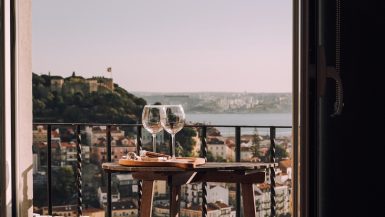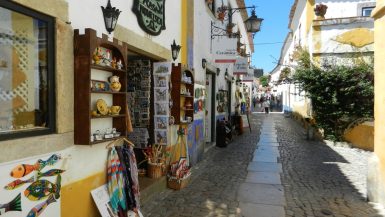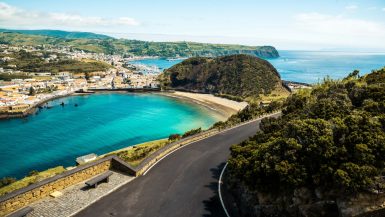
There’s oodles of snorkeling in Lagos on the menu. The enchanting capital of the Algarve region is surrounded by some of the loveliest beaches in the country. We’re talking long, gold-shimmering stretches of fine powder topped by mighty cliffs. But there are also hidden places where you can dive under to explore the seas with good visibility.
Yep, from secluded coves to ancient cave systems, there are a number of options when it comes to putting on the airpipe and goggles in this corner of southwestern Europe. You’ll encounter all sorts under the water, from deep grottoes filled with seaweed to a kaleidoscope of strange and intriguing creatures, including sea slugs, seahorses, squids, and bonefish.
Tempted? Here’s our list of the nine top spots for snorkeling in Lagos. Whether walking in from the sands, sailing in on a boat tour, or paddling over in a kayak, this list will feature something that suits. So, put on your goggles and dive into this list!
Ponta Da Piedade

Our first snorkeling spot is not a beach, but a water-bound collection of rock formations. Limestone arches, caves, and grottoes make up Ponta Da Piedade, and provide amazing scenery for a day on (or under) the sea. While this spot can be visited on foot via a hiking trail, access on a boat tour, kayak, or paddleboard will allow for a better all-round experience. Only a seven-minute drive out from the center of Lagos, Ponta Da Piedade is a regular on lists of the must-snorkel beaches in the region.
If planning a trip to this beautiful site by boat, make sure to delve into the specifics of your tour. It’s important you research and pick the right package for you. On a larger boat with more people, the route may be more touristy, with only the most well-known parts of the area on the itinerary. Taking a smaller boat tour, kayak, or stand-up paddleboard will allow for better access to the caves and grottoes of Ponta Da Piedade. It’s also worth knowing that you can only access most grottoes during low tide.
Whether boarding through the Kissing Rock or paddling past the Camel Head formation, always be cautious of rocks here – they poke out from all angles in all different shapes and sizes. Climbing in and out of the grottoes can be a little treacherous, so always take the advice of your tour guide and bring along the reef shoes. The good news is that the topography and lack of sand helps to keep the H2O very clear, giving Ponta Da Piedade some of the best visibility of any location on the south coast.
Praia da Dona Ana

Now we move to a seriously gorgeous beach situated between Lagos town and Ponta Da Piedade. Mhmm…Praia da Dona Ana is one of the most iconic beaches in the Algarve. With its marvelous cliffside surroundings, it is easy to see why. The beach is complete with hireable loungers, toilets, and shower facilities, along with snack bars and restaurants, but really it’s all about the soaring cliffs and the dramatic rock stacks that carve and chop up this run of coastline.
It’s the very same cliffs of Ponta da Piedade that make the waters at Praia da Dona Ana remarkably still. This, along with their reputation for being very clean, makes the spot attractive to snorkelers. There is an abundance of underwater plant life to be seen below the surface, including multi-colored seaweed blooms and plumes of darting sardine fish. Be warned, however, the water here is known for being very cold, even in the summertime.
One of the best things about snorkeling in Praia da Dona Ana is that the beach faces due east into a large bay. That helps to keep it protected from the onslaught of westerly swells that make this part of Portugal such a surf mecca. During the summer months, it’s usually as flat as a pancake and you can easily swim out to the small clusters of stone to see limpets and small fish by the bucket load.
Praia do Pinhão

Be ready to be wowed by Praia do Pinhão. This small cove on a small bay is perfect for a secluded summer afternoon’s snorkeling. Located near Dona Ana, this similarly rocky beach contrasts by being a favorite of local families rather than a hotspot for tourism. If you make your trip early, it’s likely you could have it all to yourself.
There are two sides to Praia do Pinhão, connected by a tunnel in the rocks on the beach. One side is much smaller and only accessible during low tide. There are no restaurants on this beach, so if you’re planning on spending the whole day here it’s worth bringing some snacks or a packed lunch. In fact, there are no facilities at all, and that includes lifeguards. So, be careful on your snorkel adventure!
The rock formations around the beach create some protection from strong winds and the water is very clear. This makes Praia do Pinhão an ideal location for snorkeling in Lagos. On the left side of the beach, there is also a great spot for cliff jumping and diving, but that’s only for the very brave.
Praia do Camilo

Located between Praia da Dona Ana and Ponta Da Piedade (which is actually only a short walk away), this is one of the most visually striking beaches in the region. Yep, Praia do Camilo is considered one of the best things to do in Lagos on TripAdvisor, despite being a relatively small beach. The sands are soft underfoot, and the surrounding rock formations are majestic and imposing. Accessed only via a long wooden stairway of over 200 steps, getting to Praia do Camilo can take a little effort. But, on arrival, during low tide, you will see that all of your stepping was worth it…
The waters at Praia do Camilo are simply perfect for snorkeling. The sea is shallow – basically transparent – and the winds are blocked by nearby rocks. This allows for serene swimming, and an amazing view of the life under the water. Various species of coral, fish, and other sea life can usually be witnessed at Praia do Camilo.
Praia do Camilo does suffer from crowds, popular as it is. Visits in the early morning will allow you to enjoy the beach in peace, with less commotion. Similarly, watching the sunset from the nearby cliffs is a memorable treat for the family to enjoy. The Do Camilo restaurant, located on top of the nearby cliffs, is a tempting place for an evening meal to end your day.
Praia Porto de Mos

Perhaps the most popular beach in Lagos, Praia Porto de Mos is a large Blue Flag beach that is regularly visited by summertime sun seekers. With fine golden sands to walk on and massive cliff faces on either side of the beach, this spot has a great balance of space and dramatic scenery. Despite being so popular, the four-kilometer length of the beach means that it is not often overly crowded. It is also a great place to hire a boat or a kayak, mainly thanks to the access that you get to the surrounding coves and inlets.
For snorkelers, Praia Porto de Mos is better visited during high tide. This is because the water contains lots of small rocks that are easily stepped on during low tide. When the water’s up, access is easier because you simply have to walk out over the sand. The occasional waves that roll in make it a popular option for surfers when there’s swell. That’s not so great for snorkelers, so check the forecast to avoid the rougher conditions.
Praia dos Estudantes

You can walk from the center of Lagos to the sands of Praia dos Estudantes. It’s a lovely bay with those trademark honey-tinged cliffs to its back and hulking spires of rock sprouting from the ocean to the south and north. Again, it’s an east-facing beach that has arguably some of the best swell protection of all around Lagos, which helps to crank up the visibility in the water.
We’d say stick to the fringing of reef that runs beneath the headlands at the north end of the bay. It stays shallow there for longer and you can spot big anemones and sardine schools in the water most days.
The accessibility of Praia dos Estudantes is both a blessing and a curse. It’s a blessing because you can easily get here after hanging in the city for a quick snorkel session in the afternoon. It’s a curse because it often means the sands and the water are busy, which isn’t great for spotting rarer sea creatures.
Praia de São Roque

Praia de São Roque breaks the mold since it’s not a rugged cluster of rock stacks and coves that’s perfect for daring snorkelers. Instead, it’s a long run of about three miles that starts in Lagos town to the west and runs eastwards all the way to the Ribeira de Odiáxere estuary. That’s a whole load of beach territory, meaning you can easily escape the crowds here provided you’re willing to walk far enough from the town.
The downside is that Praia de São Roque isn’t a haven for sea animals that like to live in the rock reefs and caves. It’s basically sandy from top to tail. That means it’s much better suited to beginner snorkelers and families with the kids in tow. You’re not likely to need reef shoes and access to the water is simply a case of strolling in from your camp on the beach.
Being a little more exposed than the other snorkeling locations on this list, we’d recommend keeping Praia de São Roque for the summer months only – swell can really churn up the water and cut the visibility.
Praia do Paraíso
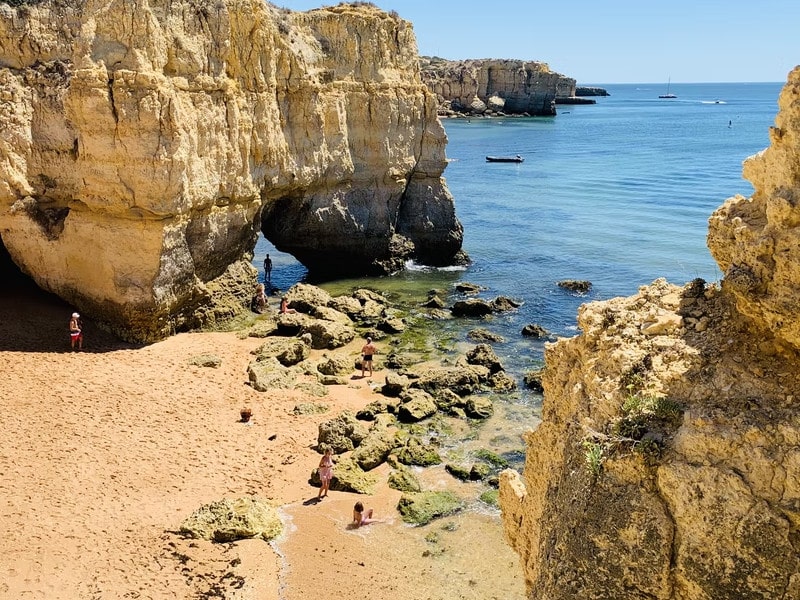
You’ll need to drive up and around the Arade River estuary to reach Praia do Paraíso from Lagos – the trip is about 40 minutes in all. Even then, the work isn’t done. The beach is small and only reachable on a pretty hairy zigzag path that’s cut into unstable cliff. To put it another way: Come here at your own risk and make sure you’re fit and experienced enough to handle some gnarly coast paths.
The reward for doing battle with the crumbling Portuguese shore is a cove that’s basically ALWAYS deserted. It’s a low tide beach because high water can cut it off entirely. A small sliver of white sand is tucked towards the back of the inlet. That leads straight into a patchwork of rock reef where there’s plenty to see for the snorkelers, from finger corals to shoals of sardines.
One thing to remember: The waves can get big here since Praia do Paraiso has a direct southwest orientation. That’s perfect for picking up all the major Atlantic Ocean swells that the surfers love. It’s better to wait for a day when there are no waves for snorkeling, though, as they’ll create a dangerous rips and ruin underwater visibility.
Praia das Furnas
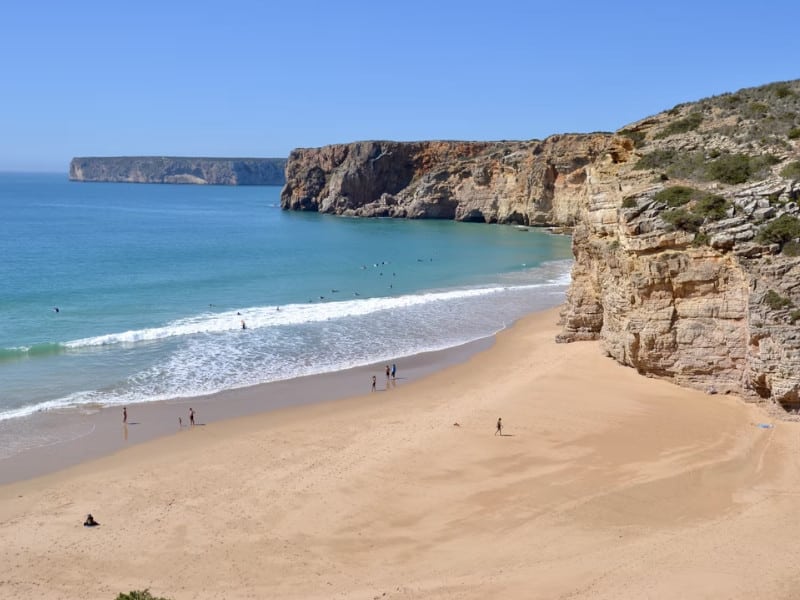
You don’t even have to bring the bikinis and swimwear if you don’t want at Praia das Furnas. See, this is the unofficial nude beach of the western Algarve. It’s also a great spot for a bit of snorkeling in the vicinity of Lagos, sat about 30 minutes’ drive down the main coast highway from the city in the direction of the Atlantic.
We’d say low tide is the prime time to come here for snorkeling. As the water peels back, it reveals a string of high rock bluffs to the eastern side of the beach and opens up the higher cliff faces to the west. Both of those are top for snorkeling sessions, providing shallows where you can get up close to colorful small fish and even peer into the occasional coastal cave.
The one thing to note about Praia das Furnas is that the shorebreak wave can be quite strong when there are bigger swells in the SW channel. It’s rarely enough to ruin a snorkel trip in the summer months, but it can be a challenge to get past as you swim out. There’s no lifeguard coverage and no organization on the beach, either, so you’ll need your own towel and supplies.
Snorkeling in Lagos – our conclusion
Lagos sits smack dab in the middle of the southwestern Algarve, a region that’s just about perfect for water babies who want to dive under and get to know the marine life of Portugal. There’s an abundance of amazing places for snorkeling in Lagos, mainly thanks to the rugged Ponta da Piedade headland that juts out to the south of the city. That’s strung by countless little beaches and bays where you can stroll right out to swim around rock stacks. It’s also home to inlets that you can only really reach with a boat or a sea kayak. This list recommends just seven individual locations for snorkeling in Lagos, all of which will be at their best in the summer months when the ocean is calmer and warmer.
Is Lagos good for snorkeling?
In short: Yes. There’s plenty of excellent snorkeling in Lagos. With a variety of beaches and coastal locations with brilliant clear waters, there is a lot to see in the region with the goggles in tow. Stunning scenery make the experience all the better, and there’s stacks of marine life to see, from dolphins to sea slugs.
Where is the best place in Lagos for snorkeling?
While not an easy choice from this list of stellar spots, our choice of the best snorkeling in Lagos has to be Ponta Da Piedade. Being the only totally water-bound location on this list gives this spot a unique edge. The necessity of aquatic travel, and the opportunities to explore the cave systems make it feel more of an adventure than the other locations. But don’t just take our word for it, book a trip to Lagos, and pick a favorite for yourself!
When is the best time to go snorkeling in Lagos?
There’s no doubt about it that the summer is the best time to hit the Algarve’s beaches for a snorkeling trip. The H2O starts to warm up properly around May time and then keeps getting warmer throughout the summer until late August until it gets to around a balmy 66-70 F (that’s around 18-20 C). You also find the clearest conditions in the summertime, which makes it easier to appreciate all those fish species and marine animals while swimming.
